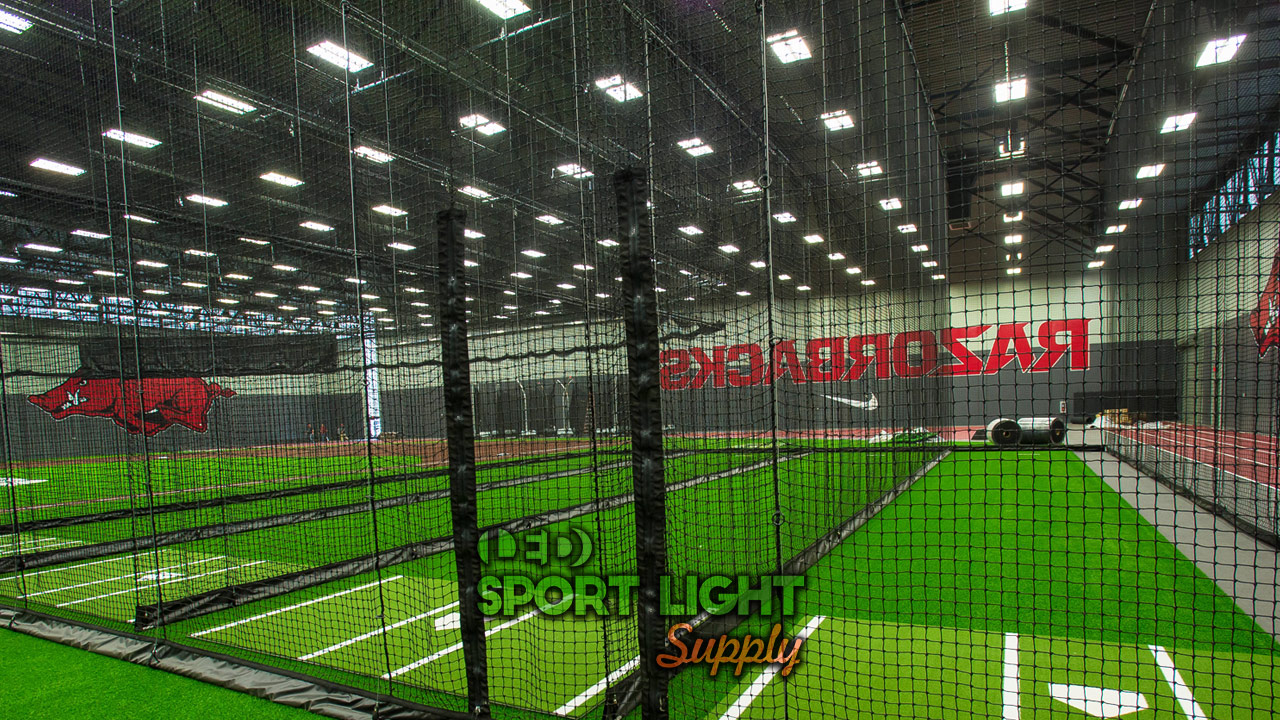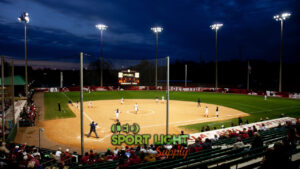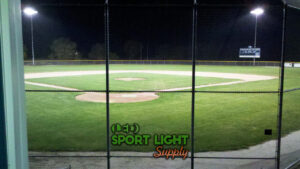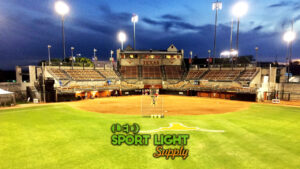In order to simplify the mechanics of the batting, a batter must master three key elements. That is, hand-eye coordination, bat speed, and hand position. Usually, batting practice starts around 6.00 PM and lasts for at least one hour.
No baseball player gets into the Major League without proper training. And when you enter the batting cage, you need to keep an eye on many other things. For example, the feet position, bending of the knees, and creating solid contact.
For all this kind of training, the correct lighting is essential. But sometimes, you cannot train in the evening because the LED light fixture is broken. Well, here is a simple DIY project to change the broken flood light yourself. I am going to give you the batting cage lighting ideas of what you need to know and do.
This Ultimate How To guide will explain what lumen rating and wattage to look for. Plus, everything else you need. You will find technical knowledge, as well. And it is all here in simple words. Of course, no prior experience or skill is necessary.
Why do we need to DIY batting cage lighting?
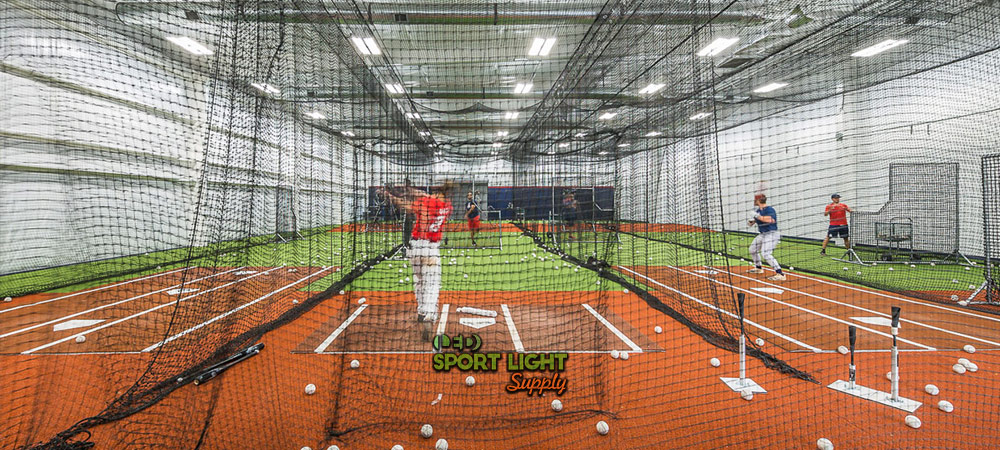
You might have tried to avoid solving this issue during the warm seasons. But as the colder seasons approach, the right lighting setup is necessary to keep your eyes on the ball. At the same time, the LED fixtures mirror the same lighting of the baseball field.
If even one flood light stops working, poor lighting will not let you keep up with the pitching machine. So, you need to fix the LED lights for maximizing the training session.
At first, you might not be so keen to do it yourself. But buying the lights and installing them in the batting cage by yourself is easy. So, before we begin discussing how to select and replace the light sources, here are the reasons why you should do-it-yourself.
1. Saving costs
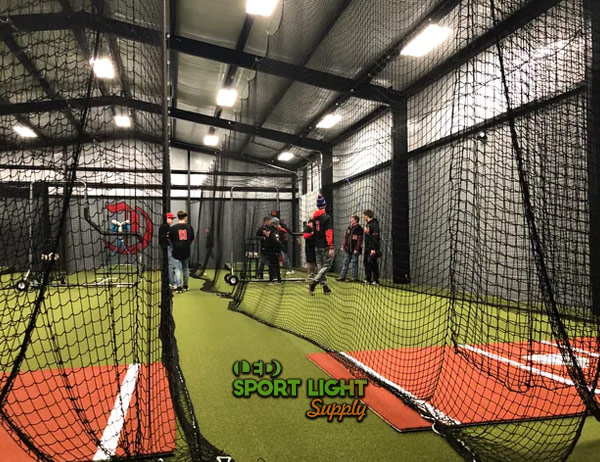 The most obvious reason is practicality. You can just buy the proper flood lights and install them in a jiffy. In other words, you can skip hiring an electrical contractor. No electrician to pay. No waiting due to experts’ delays because they are always too busy.
The most obvious reason is practicality. You can just buy the proper flood lights and install them in a jiffy. In other words, you can skip hiring an electrical contractor. No electrician to pay. No waiting due to experts’ delays because they are always too busy.
When you shop for a new flood light and know what to look for, you will save on the material. Plus, you are sure to select the right light for your needs. In the end, reading the product specs is not hard at all.
By the time you finish reading this how-to guide, you will be more than prepared to create a suitable lux level for your batting cage. After you understand the difference between lumen and lux, you will be ahead of the curve.
2. Higher flexibility
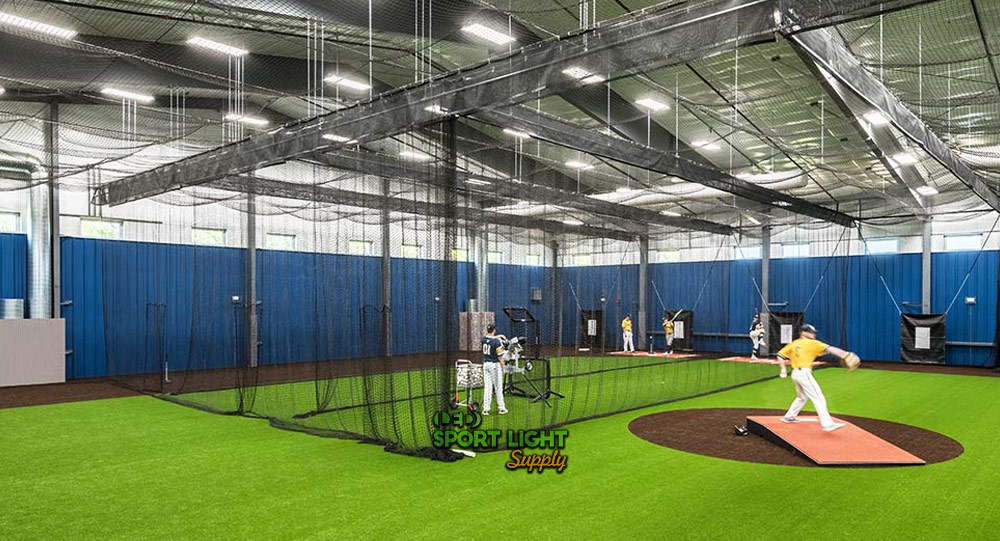
Getting the new LED lights gives you an opportunity to improve the overall purpose of the batting cage. In fact, you can control more than how bright your lights need to be. You can select LED flood lights with dimmer to adjust the brightness. Better yet, light fixtures that support smartphone control.
The latest LED lights are ideal for simple DIY projects. For one thing, they let you set different settings or profiles. They are cost-effective, reliable, and long-lasting. Then again, you can remote control the lights without having to waste precious time.
If you need to repair the lights, here is another DIY idea. You can choose smaller, easier to install light bodies with a higher lumen value. In this way, you can remove or rotate them to light another area. You can use dedicated poles outside the batting cage and dimmable lights for the best results.
3. Easy to repair
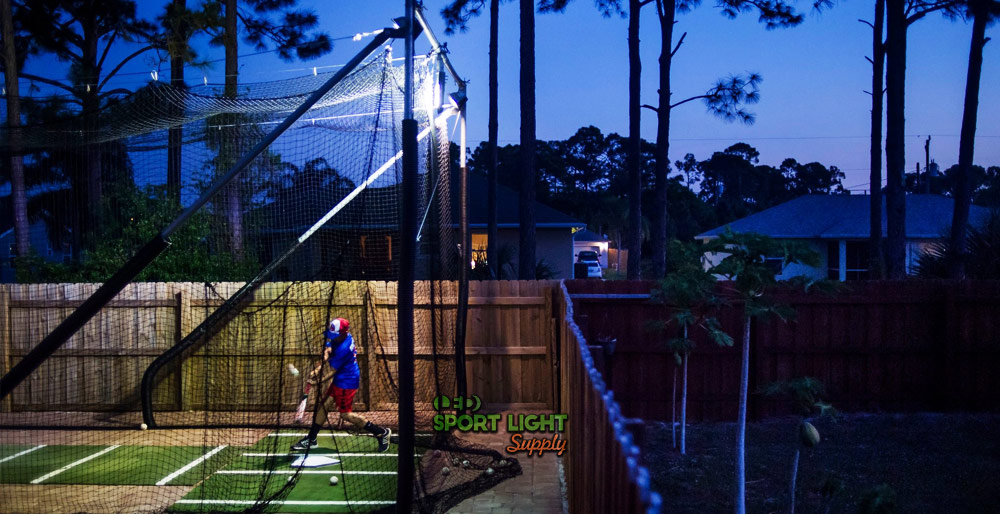
When you know what to buy, it is easier to find a replacement bulb from a reliable manufacturer. You do not need advanced lessons on how to replace LED lights. In fact, the LED tech is most likely the easiest one to install.
While it is true that replacing other types of light floods may be complicated, changing a LED flood light is no big deal. If you need to replace the old LED light, you just buy and install the new one. Generally, you do not need to redo the electric circuits or modify the power supply.
To repair it yourself, all you need is some free time. You should spend most of your time selecting the appropriate lumen output for the required lux level. We will tackle this subject later so that you can make more savvy purchases.
What kind of lights does a batting cage need?
Each batting cage requires you to choose a fit light design for it. Generally speaking, it all starts with selecting the right light source. Luckily, you only need one type of LED flood light if you place the batting cage outside. Similarly, you switch to a different type for indoor installations.
Usually, you are better off choosing LED light fixtures. Considering the use of the training equipment, you only need enough lights to provide a well-lit environment. It is almost trivial. In fact, it is only necessary to illuminate the hitter’s area.
We are going to see two kinds of LED lights. Basically, they are the most commonly used lights in baseball stadiums all over the world. More importantly, they are easy to install and require little to no maintenance.
1. Flood lights or spot lights for outdoor batting cages
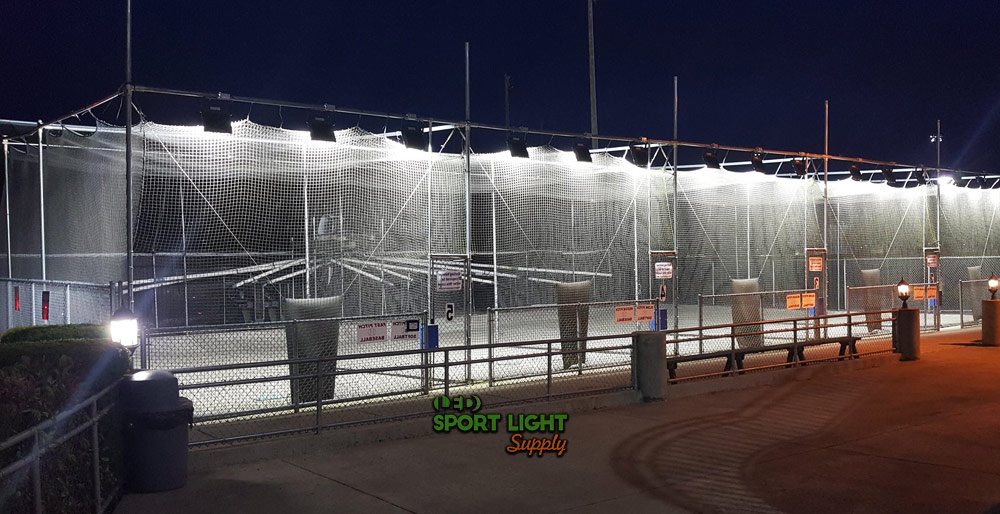
LED flood lights and spot lights are ready to use. Generally speaking, you can place them anywhere you need to. They are available in varying wattages and sizes for either the small and the modular batting cage.
Sports facilities with multiple batting cage systems can rely on larger flood lights to light the whole batting area. In fact, flood lights have a wide beam of light. They provide lighting uniformity and low glare illuminance. In short, they allow every player to practice with the perfect lighting conditions.
Alternatively, you can opt for spot lights. Unlike a flood light, a spot light has a narrow, brighter beam of light. In other words, it is ideal for long-distance lighting. You can also install a spot light on a distant wall to support the current lighting system.
2. High bay lights for indoor batting cages
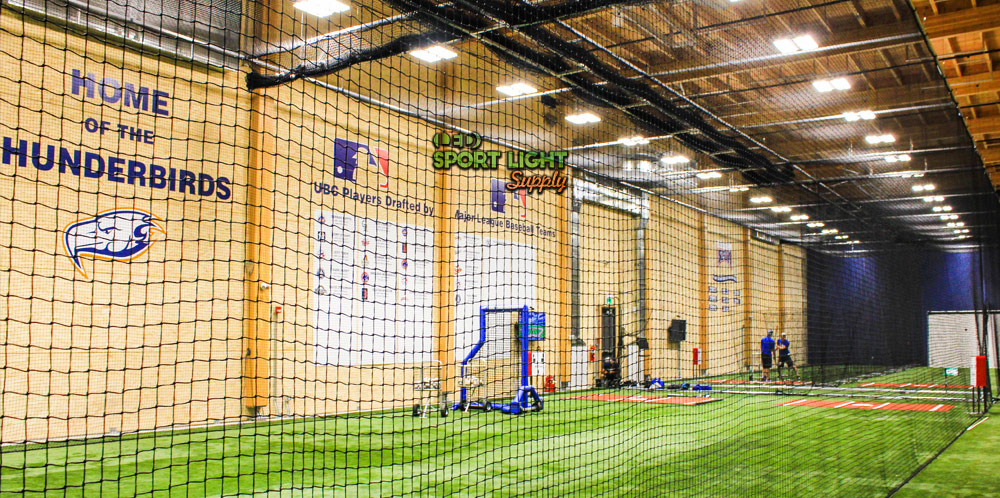
If you have an indoor batting cage, you probably want to install some kind of ceiling light. Well, high bay lights are the most cost-efficient solutions for indoor baseball practice that you can mount on the ceiling. They are also very popular in athletic facilities.
Of course, you might need more high bay lights to illuminate a large room. But LED high bay lights help you with that. The reduction of energy consumption is an achievable goal. Certainly, these low-consumption lights will let you gain all the light you need at the lowest price.
LED tech is the best solution for this type of problem. In comparison with other types of lights, energy savings can range from 50 to 80%. Of course, you might need to get a movable staircase for a faster installation. You still need to install them on the ceiling.
How to light up a batting cage – A DIY Guide
1. How many lux and lumens needed for the batting cage?
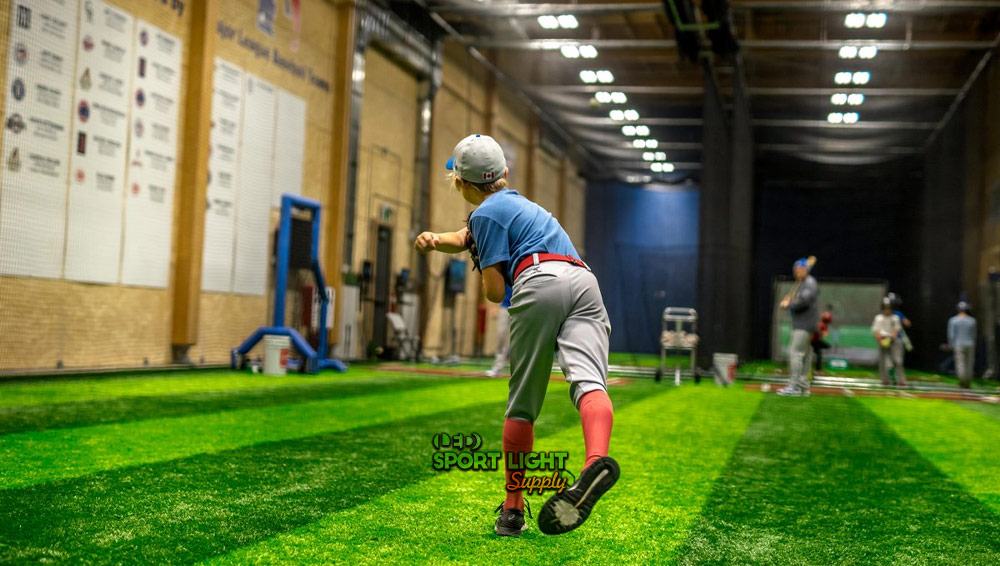
Lighting is a matter of lumens. Today, when we need to buy a lamp, the package does not only indicate the wattage but the lumen as well. Indeed, reading the lumen value on the label helps you to create the perfect lighting design. That is when we talk about lux.
To specify, lumen and lux refer to different concepts. In essence, lumen equals brightness. Instead, one lux equal one lumen spread over a squared meter.
To begin with, for recreational use, you need 200 to 300 lux. In high school, college or club facilities, 400 to 500 lux are necessary. Otherwise, you would strain your or students’ visual capacity.
Here is a formula to help you find the right ratio:
Minimum lumen needed = lux x batting cage floor area (in sq. meter)
Let us say you need 200 lux lighting for batting cage because you just want to train in your free time. Also, the batting cage size is 100 sq. meter. So, the lumen required are 200 x 100 = 20,000 lumens.
Here is a pro tip. Actually, it is better to multiplicate the final value for 1.25 to compensate for light loss. In the end, the real total lumen output you need for batting cage is 20,000 x 1.25 = 25,000 lumens.
2. How much wattage do batting cage lights use?
After you find out how many lumens you need, you have to figure out the wattage of the batting cage lights. This is also useful in case you only need to change one flood light.
Here is how to calculate the wattage required for LED lights. Assuming a single LED light source has a luminous efficacy of 150 lumens per watt:
Wattage needed = Lumen/150 lumens per watt.
For example, if you need at least 20,000 lumens, calculate:
20,000 lumens/150 = 133 watts LED
As you can see, you will find LED lights that provide 100 or 150 Watts. In this case, get the more powerful one. That is the reason why the lux level comes in the form of a range. As long as you keep the overall score between the recommended range, you will enjoy a comfortable vision.
3. Where to place the batting cage lights?
Usually, you need to install the indoor batting cage lights at the corners of the room. Or one at each pole for the outdoor training area. You can use several floodlights indoor or just two spot lights.
For backyard batting cage, the light poles you used to install the net should do. Besides, the outdoor frame of commercial models could already have a dedicated spot for installing flood lights.
Depending on the location, maybe you want to further protect your lights. Be sure to check the International Protection Code. To clarify, each flood light comes with a rating that specifies how well the light body resists to dust, water, etc.
If you can, get IP61 light fixtures. Basically, you can place them almost anywhere you can.
Tips for selecting the best batting cage lights
1. Using a large beam angle to give broad coverage
As the batting cage is not very tall, you need a wide beam angle LED flood light to spread the light over a short distance. That is, creating an even light distribution for better illuminance.
On balance, the beam angle ranges from a minimum amplitude of 10° up to 120°. Mostly, it depends on the type of lamp because of the light body design.
Most flood lights have a beam angle of 60 degrees or more. On the other hand, spot lights have narrower luminous fluxes. For a spot light, 60 degrees denote an upper limit.
Broad coverage does not mean that the amount of brightness changes. In fact, calculating the lumen vales will give you perfect illuminance.
2. Light-weight luminaries
The thin pole may not tolerate the heavy lighting fixtures, so what do you do? Luckily, you can always use light-weight luminaries. That is, mini versions of more chunky light fixtures.
Adjustable spot lights may be the ideal solution for most cases. Many types of spot lights exist:
- round or square spotlights
- wall-mounted or recessed
- fixed or adjustable
Once you created a lighting layout, you can select the best spot lights according to your needs.
If you plan to illuminate large areas such as multiple batting cages, the fixed ones are the right for you. If, on the other hand, you need to light up different points, then the adjustable ones are the most suitable for this task. For example, the batting cage on one side of the backyard and a portable pitching mound on the other.
3. Using LED instead of halogen
You might be tempted to buy halogen lights. After all, many sellers try to sell their inventory at discounted prices. But I suggest you pick and choose only LED lights.
This is the reason why: LED lights let you save on your electric bill. These light fixtures are not only energy-saving but also long-lasting (>150,000 hours). Above all, LEDs emit light that passes through the fog better, making even small objects more visible.
The main risk associated with the use of halogen lamps is due to ultraviolet rays. When you light a halogen lamp, ultraviolet rays come out. Sadly, they are harmful to the human eye and can cause skin cancer.
In fact, in halogen lamps, the bulb is not made of glass but of quartz. This material is much more resistant to high temperatures, but it does not block ultraviolet rays.
4. Using solar batting cage lights
If you want to go green, you can opt for solar batting cage lights. These lights will transform your DIY project into a meaningful statement on the environment.
Of course, we are discussing an idea that will make your batting cage easier to manage. For one thing, the whole lighting system becomes wireless. This means no hassle. And no electric bill.
The solar panel can charge during the daytime. Moreover, maintenance is next to zero. Once in a while, you pick a ladder to clean the photovoltaic module, and you are done. On the other hand, this solution is only suitable for the outdoor batting cage.
Because you only need a couple of lights for most batting cages, solar LED lights will do in the open. But you would have to invest more money for more panels to light an indoor area.
5. Sturdy lighting fixture
Whatever you do, do not install fluorescent tubes. Remember that batting involves balls moving at high-speed. When the hitter makes contact with the ball, the baseball could fly anywhere. So, you need sturdy lighting fixtures that can withstand any accidental impact.
The casing and light body parts must resist the impact of fast-moving baseballs. To be precise, you should want to avoid fluorescent tubes because mercury leaks out of the tube if the baseball hits it.
Exposure to mercury in its elemental state affects the respiratory system. For example, inhalation of its vapors causes cough, chills, fever, and breathlessness. On the skin, it could cause mild swelling, blistering, peeling, irritation, and hives. So, no fluorescent tubes.
Once released into the environment, mercury becomes toxic. Moreover, bacteria and other organisms can turn it into methylmercury. If the latter makes it into the groundwater, it will contaminate the fishes and the humans who eat them.
6. Color temperature
LED lights allow you to change or select a preferred color temperature. In other words, it let you choose between a warm white and cool white light, depending on the players’ preference.
Each part of the light spectrum includes several colors. In detail, some of the colors that compose light are stronger than others.
People mostly refer to bright white light as cool white light (between 3100K and 4500K in the product specs). Instead, you use the term warm white (2000K to 3000K) when you talk about a yellowish light. Warm light resembles daylight, and it is sometimes available with reddish shades.
Not every type of lamp lets you choose the color temperature. Of course, LEDs let you pick both color temperatures. But halogen lights only provide warm lights. Metal halide lamps give you cool bluish light. And so on. Make sure to read the specs on the package for more details.
Common mistakes DIYers make with batting cage lighting
1. Too bright lighting
The upper lux limit is there to remind you of the problem of glare. In short, too bright light turns you blind. This is the reason why you must calculate the minimum lumen needed. If you slightly increase this value, nothing bad will happen. But if you overdo the lighting, you will blind anyone in the batting cage. Plus, you could actually cause light pollution and disturb the neighborhood.
2. Too dim lighting
If you cannot see the baseball, the training session will be futile. Adequate lighting must provide the batter with the proper uniformity of illuminance. That is, a suitable light level. Here is the easiest and quickest fix: ask for a photometric study. As professionals, our company can provide free lighting consultation. People like us help you understand how to optimize your training area. Then, the photometric study gives you precise data and a general idea of what you need to do.
3. Incorrect orientation
When you install each flood light, you need to orientate them the right way on the same central spot. Otherwise, they will produce glare, shadow, and uneven lighting. This could cause all sorts of negative consequences. For example, picking up bad baseball habits. Correcting hitting mechanics takes up too much time. Instead, you should spend that time improving other skills. Here are some of baseball’s bad habits you might incur:
- moving back and forward to see better
- remaining still like a statue or getting tense
- shortness of breath because you do not have enough time for sprint workouts
4. Wrong power input
Sometimes, you might find out that the LED light goes off immediately when you plug it in. Some light flood models only work with precise voltage and power values. If this happens, check for the details on your DC or AC power supply. If this does not help, here is how to fix this issue. Ask the manufacturer for the batting cage lighting specifications. You might find out that your batting cage only uses constant voltage LED products. But do not worry, the manufacturer can help you find the right light on your own.
How much does it cost to light a batting cage?
1. Batting cage flood light cost
Just to give you an idea, a lamp costs around $0.6 to $1.5 per watt (LED). Of course, different DIY projects may call for varying lighting solutions. But usually, the LED lights will not break the bank. More pricey flood lights might come with better IP ratings or special heatsinks to keep up with an astonishing lumen output. On the market, you can find plenty of options to customize your batting cage.
2. Installation cost
It can be zero if you install it by yourself. But if you do not know how to install everything, you can hire an electrical contractor. You should also hire an expert electrician if you are not confident in dealing with electric circuits. Nonetheless, you can still save money by buying the lamps on your own! Indeed, the whole service package can be extremely expensive. But if you buy the lamps, you will only pay for the installation service.
Conclusion
You can use this guide to create simple DIY projects. First, check if your batting cage frame comes with mounting brackets. The traditional baseball batting cage installation kit just gives you the wires and turnbuckles. Then, select the right LED light with adequate lumen output and light appearance. You can immediately install them as soon as they arrived. Make sure to place them at the correct distance for the required lux level. At last, orientate each light fixture accordingly to your needs.

